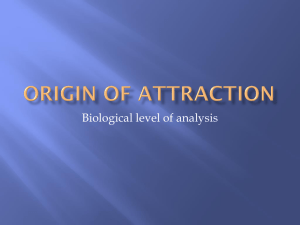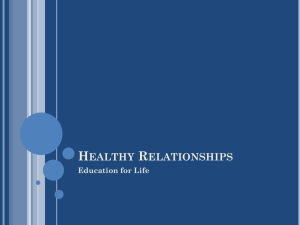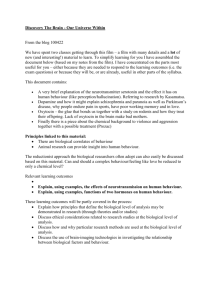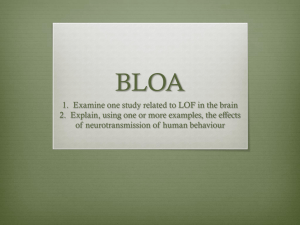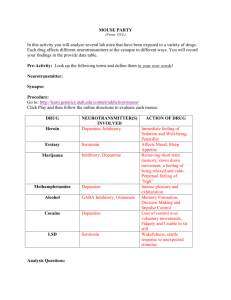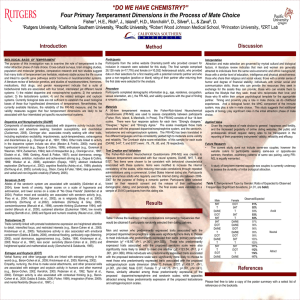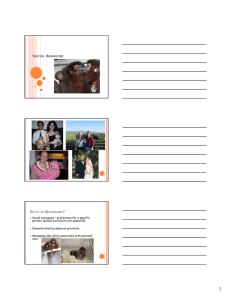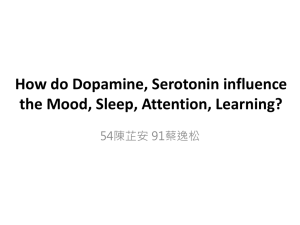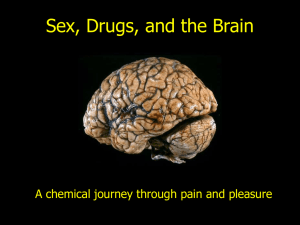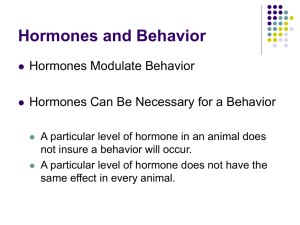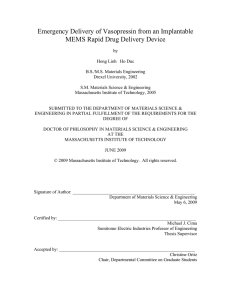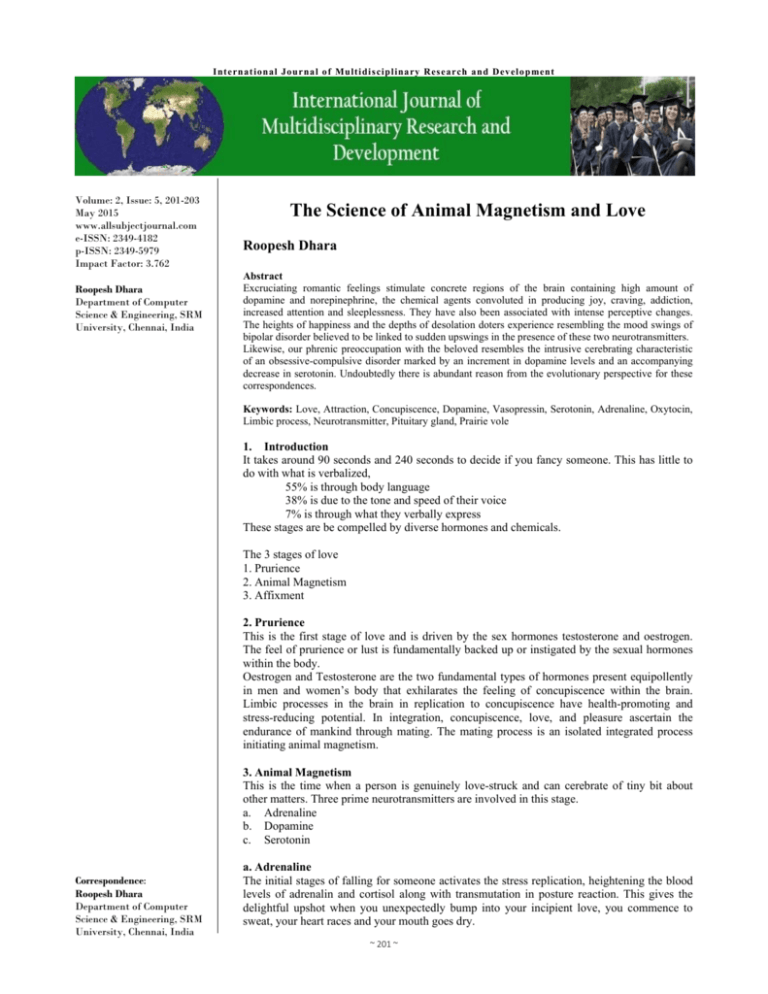
Intern at ional Jo urna l of Mult idisciplinary Research and Dev elo pmen t
Volume: 2, Issue: 5, 201-203
May 2015
www.allsubjectjournal.com
e-ISSN: 2349-4182
p-ISSN: 2349-5979
Impact Factor: 3.762
Roopesh Dhara
Department of Computer
Science & Engineering, SRM
University, Chennai, India
The Science of Animal Magnetism and Love
Roopesh Dhara
Abstract
Excruciating romantic feelings stimulate concrete regions of the brain containing high amount of
dopamine and norepinephrine, the chemical agents convoluted in producing joy, craving, addiction,
increased attention and sleeplessness. They have also been associated with intense perceptive changes.
The heights of happiness and the depths of desolation doters experience resembling the mood swings of
bipolar disorder believed to be linked to sudden upswings in the presence of these two neurotransmitters.
Likewise, our phrenic preoccupation with the beloved resembles the intrusive cerebrating characteristic
of an obsessive-compulsive disorder marked by an increment in dopamine levels and an accompanying
decrease in serotonin. Undoubtedly there is abundant reason from the evolutionary perspective for these
correspondences.
Keywords: Love, Attraction, Concupiscence, Dopamine, Vasopressin, Serotonin, Adrenaline, Oxytocin,
Limbic process, Neurotransmitter, Pituitary gland, Prairie vole
1. Introduction
It takes around 90 seconds and 240 seconds to decide if you fancy someone. This has little to
do with what is verbalized,
55% is through body language
38% is due to the tone and speed of their voice
7% is through what they verbally express
These stages are be compelled by diverse hormones and chemicals.
The 3 stages of love
1. Prurience
2. Animal Magnetism
3. Affixment
2. Prurience
This is the first stage of love and is driven by the sex hormones testosterone and oestrogen.
The feel of prurience or lust is fundamentally backed up or instigated by the sexual hormones
within the body.
Oestrogen and Testosterone are the two fundamental types of hormones present equipollently
in men and women’s body that exhilarates the feeling of concupiscence within the brain.
Limbic processes in the brain in replication to concupiscence have health-promoting and
stress-reducing potential. In integration, concupiscence, love, and pleasure ascertain the
endurance of mankind through mating. The mating process is an isolated integrated process
initiating animal magnetism.
3. Animal Magnetism
This is the time when a person is genuinely love-struck and can cerebrate of tiny bit about
other matters. Three prime neurotransmitters are involved in this stage.
a. Adrenaline
b. Dopamine
c. Serotonin
Correspondence:
Roopesh Dhara
Department of Computer
Science & Engineering, SRM
University, Chennai, India
a. Adrenaline
The initial stages of falling for someone activates the stress replication, heightening the blood
levels of adrenalin and cortisol along with transmutation in posture reaction. This gives the
delightful upshot when you unexpectedly bump into your incipient love, you commence to
sweat, your heart races and your mouth goes dry.
~ 201 ~ International Journal of Multidisciplinary Research and Development
b. Dopamine
Incipiently love struck couples have high calibers of the
neurotransmitter dopamine. This chemical kindles craving and
incentive by triggering an excruciating rush of indulgence. It
has the identical result on the brain as using cocaine.
Couples often show the denotements of surging dopamine:
incremented energy, less desideratum for slumber or victuals,
focused attention and exquisite delight in most minute details
of their relationship.
c. Serotonin
One of love's most consequential chemicals that may expound
why when you’re falling in love, your incipient doter keeps
popping into your phrenic conceptions. Early love (the animal
magnetism phase) authentically transmutes the way you
cerebrate. Serotonin levels of incipient doters are equipollent
to the low serotonin levels of Obsessive-Compulsive Disorder
patients.
Incipiently smitten doters often idealise their partner,
magnifying their virtues and explicating away their
imperfections.
Incipient couples additionally exalt the relationship itself. It's
very prevalent to cerebrate they have a relationship that's more
proximate and more special than anyone else's. This view
makes a couple want to cohere to enter the next stage of love
– affixment.
4. Affixment
Annexation is the bond that keeps couples together long
enough for them to have and raise children. Two major
hormones are involved in this feeling of annexation:
a. Oxytocin
b. Vasopressin
a. Oxytocin
Oxytocin is a potent hormone relinquished by men and
women during orgasm.
It probably deepens the feelings of annexation and makes
couples feel much more proximate to one another after they
have orgasmed.
Oxytocin withal seems to avail cement the vigorous bond
between mum and baby and is relinquished during childbirth.
It is additionally responsible for a mum’s breast automatically
relinquishing milk at the mere optical discernment or sound of
her puerile baby.
If you block the natural relinquishment of oxytocin in sheep
and rats, they abnegate their own puerile.
Contrariwise, introducing oxytocin into female rats who’ve
never orgasmed, caused them to fawn over another female’s
puerile, nuzzling the pups and forfending them as if they were
their own.
b. Vasopressin
Vasopressin is another consequential hormone in the longterm commitment stage and is relinquished after sex.
Albeit the brains of men and women are structurally different,
they both secrete vasopressin from the pituitary gland.
Vasopressin (withal called anti-diuretic hormone) works with
your kidneys to regulate longing. Its probable role in longterm relationships was descried after observing the prairie
vole.
Prairie voles indulge in far more sex than is stringently
compulsory for the purposes of reproduction. They form
legitimately stable pair-bonds.
Once male prairie voles are given a drug that subdues the
effect of vasopressin, the bond with their partner deteriorated
immediately as they tend to lose their devotion and fail to
forfend their partner from incipient suitors.
The calibers of vasopressin is in cognation to:
Larger gregarious network
Greater spousal support
Relationship maintenance
Lesser negative communication
Interpersonal functioning
More annexation security
5. Acknowledgement
We wish to thank our friends and college for fortifying us in
consummating our work regarding Attraction and Love. We
withal wish to thank our parents for providing us with assets
that availed us consummating research regarding this concept.
6. References
1. The Handbook of Evolutionary Psychology, edited by
David M. Buss, John Wiley & Sons, Inc., 2005. Chapter
14, Commitment, Love, and Mate Retention by Lorne
Campbell B. and Bruce J. Ellis.
2. "Evolutionary psychology: the emperor's new paradigm"
by D. J. Biller in Trends Cong. Sci. (2005) Volume 9
pages 277-283.
3. The Mating Mind: How Sexual Choice Shaped the
Evolution of Human Nature by Geoffrey F. Miller
in Psycoloquy (2001) 12,#8.
4. Evolution of human music through sexual selection by
G. F. Miller in N. L. Walling, B. Marker, & S. Brown
~ 202 ~ International Journal of Multidisciplinary Research and Development
5.
6.
7.
(Eds.), The origins of music, MIT Press, (2000). pp. 329360.
Sexual selection and mate choice in evolutionary
psychology by
C.
Hafez
in
Biology
and
Philosophy doi:10.1007/s10539-007-9071-0
Griffith J. 2011. What is Love? In The Book of Real
Answers
to
Everything ISBN
9781741290073. http://www.worldtransformation.com/w
hat-is-love/
Susana, Robert W. (2004). The Origins and Nature of
Sociality. Transaction Publishers. p. 432. ISBN 978-0202-30731-2.
~ 203 ~

